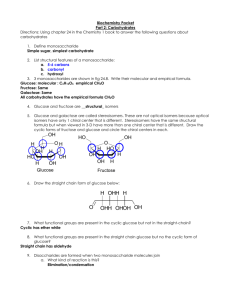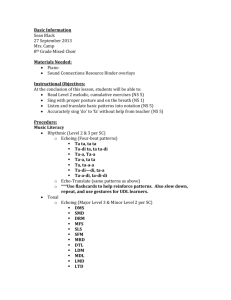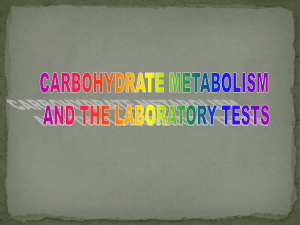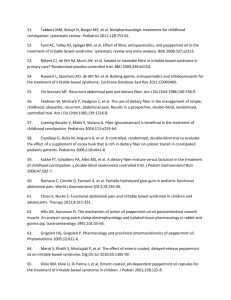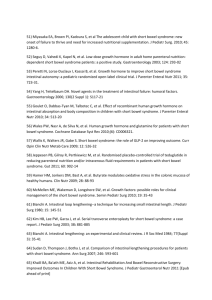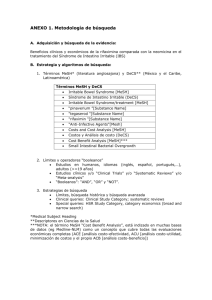glucose breath test
advertisement
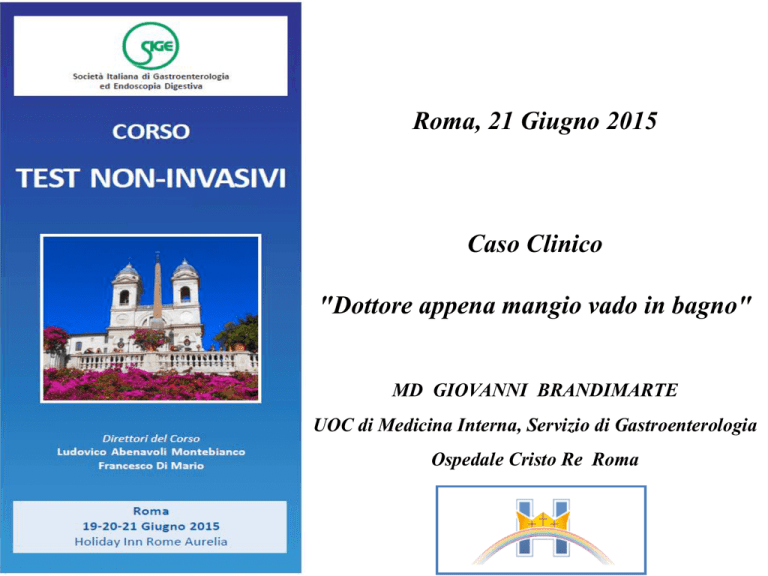
Roma, 21 Giugno 2015 Caso Clinico "Dottore appena mangio vado in bagno" MD GIOVANNI BRANDIMARTE UOC di Medicina Interna, Servizio di Gastroenterologia Ospedale Cristo Re Roma Dottore, ogni volta che mangio vado al bagno…. STORIA CLINICA Francesco 31 aa Bancario. ABS fino a 4 mesi fa. Non fuma. Non riferisce patologie nè allergie. Episodi di MRGE trattati con successo con PPI. Da circa 4 mesi riferisce 3 eva/die post-prandiali, feci morbide, senza sangue né muco. Non riferisce viaggi all’Estero nè assunzione di pesce crudo. ORGANIC DISEASE ? FUNCTIONAL DISEASE ? OWERLAPPING DISEASE ? IRRITABLE BOWEL SINDROME SMALL INTESTINAL BACTERIAL OVERGROWTH LACTOSE INTOLERANCE CELIAC DISEASE INFLAMMATORY BOWEL DISEASE OTHER EGDS? IBS Prevalence of organic diseases in patients Meeting symptom-based criteria for IBS American College of Gastroenterology Task Force in IBS Am J Gastroenterology 2009; 104:S1-S35 Linee Guida della Federazione AIGO - SIED - SIGE RSCS? Linee Guida della Federazione AIGO - SIED - SIGE "Dottore potrei avere un Crohn od una CU?" Che cosa potrei fare per escludere una malattia infiammatoria cronica intestinale? Devo sottopormi ad esami invasivi? INFLAMMATORY BOWEL DISEASE Aim: To evaluate the utility of C-reactive protein (CRP), erythrocyte sedimentation rate (ESR), fecal calprotectin and fecal lactoferrin to distinguish between patients with IBS and IBD and healthy controls (HCs). Pertanto il Medico cosa prescrive al pz? • Emocromo con Mucoproteine formula, VES, • Calprotectina fecale • Sangue Occulto Fecale su tre campioni PCR, Esami richiesti • G.R. 5.230.450, Hb 14.6, MCV 88.4, PLT 248600, G.B. 8650. • Calprotectina Fecale: 15 µg/g. • Sangue Occulto Fecale su tre campioni negativo. EO: addome piano, dolorabile alla palpazione profonda in fossa iliaca destra, peristalsi presente e valida, intenso meteorismo diffuso su tutto l’ambito. ER: negativa, feci in ampolla rettale. "Dottore potrei avere un colon irritabile?" Che cosa potrei fare per confermare il mio colon irritabile? Devo sottopormi ad ulteriori esami? Criteri di Roma III – Irritable Bowel Syndrome Recurrent abdominal pain or discomfort at least 3 days/month In the last 3 months associated with 2 or more: Improvement with defecation and Onset associated Onset associated with a change in with a change in and form frequency of (appearance) of stool stool * Criteria fulfilled for the last 3 months with symptom onset at least 6 months prior to diagnosis. Longstreth GF, Gastroenterology 2006 Irritable bowel syndrome (IBS) is the most frequently diagnosed functional gastrointestinal disorder in primary and secondary care. It is characterised by abdominal discomfort, pain and changes in bowel habits that can have a serious impact on the patient’s quality of life. The pathophysiology of IBS is not yet completely clear. Genetic, immune, environmental, inflammatory, neurological and psychological factors, in addition to visceral hypersensitivity, can all play an important role, one that most likely involves the complex interactions between the gut and the brain (gut-brain axis). Nevertheless, the severity of the patient’s symptoms or concerns sometimes compels the physician to perform useless and/or expensive diagnostic tests, transforming IBS into a diagnosis of exclusion. "La diagnosi di colon irritabile è una diagnosi di esclusione" Le consiglio di eseguire i test del respiro. Breath test al Lattosio Breath test al Lattulosio o Glucosio Breath test al Sorbitolo Breath tests are non-invasive tests and can detect H2 and CH4 gases which are produced by bacterial fermentation of unabsorbed intestinal carbohydrate and are excreted in the breath. Breath tests are inexpensive, simple and non-invasive, inexpensive tests which can be used for: Evaluation of carbohydrate maldigestion; Detection of excess bacteria in the small intestine; Estimation of intestinal transit time. Breath testing consists of measurement of H2/methane (CH4) produced by bacterial fermentation of unabsorbed carbohydrate that is ingested by subjects. Subsequent breath samples are collected at specific time intervals (i.e., every 15 or 30 min) for 2-5 h. CO2 is produced by all cells during metabolism, but only bacteria produce H2 and CH4 as metabolic byproducts. Thus, if either H2 and/or CH4 are produced in body, this proves that a substrate has been exposed to intestinal bacteria with leading tobacterial fermentation. Urita Y et al World J Gastroenterol 2006; 12:4 . Hamilton L. 2nd ed. Milwaukee: QuinTron Instrument Company, 1998. LACTOSE MALABSORPTION Lactose, a disaccharide composed of glucose and galactose bound in a ß-glycosidic linkage. Absorption of lactose requires lactase-phlorizin hydrolase (LPH) activity in the small intestinal brush border to break the linkage between the two monosaccharides, a step preceding the transport of glucose and ⁄ or galactose across the brush border membrane. Lactose malabsorption represents a well-known cause of abdominal disorders, like diarrhoea, bloating, excessive flatus and abdominal pain. Lactose malabsorption testing should be recommended in subjects complaining of these symptoms after lactose ingestion. However, sugar malabsorption does not necessarily result in the development of intolerance symptoms; infact, only about one-third to half of lactose maldigesters are also intolerants. Simren M et al. Gut 2006; 55. Vesa T et al. J Am Coll Nutr 2000; 19. Peuhkuri K et al. Am J Clin Nutr 2000; 71. LACTOSE BREATH TEST For effective utilization, lactose requires hydrolysis by the enzyme lactase. The breath test is now being considered to be the most practical and dependable method to diagnose malabsorption of lactose. On the basis of reviewing different studies, lactose breath test shows good sensitivity (mean value of 77.5%) and excellent specificity (mean value of 97.6%). Corazza GR et al. J Lab Clin Med 1994; 124. Newcomer AD et al. N Engl J Med 1975; 293. Metz G et al. Lancet 1975; 24. Szilagyi A et al. Clin Gastroenterol Hepatol 2007; 5. Hiele M et al. J Lab Clin Med 1988; 112. Strocchi A et al. Gastroenterol 1993; 105: 1404–10. Lactose intolerant Lactose tolerant SORBITOL BREATH TEST Sorbitol is found in stone fruits, and also used as an artificial sweetener in sugar-free gum and mints. It is poorly absorbed in small intestine. Sorbitol breath test determines if an individual can absorb small amount of sorbitol. This can help to decide if dietary restriction of sorbitol can lead to improvement in gastrointestinal symptoms. Sorbitol intolerant Sorbitol tolerant Vati Rana S et al. World J Gastroenterol 2014 June 28; 20(24). SORBITOL BREATH TEST Tursi et al. in our study compare the effectiveness of the sorbitol H2 breath test (H2-BT) and serological tests (antigliadin (AGA), antiendomysium (EMA) and anti-tissue transglutaminase (anti-tTG) as screening tests in the detection and estimation of celiac disease (CD) prevalence in 1st-degree relatives. Was screened 111 1st-degree relatives of 37 coeliac families. Relatives with abnormal serological tests and/or with sorbitol H2-BT positivity underwent a small-bowel biopsy. Small-bowel biopsy was also performed in relatives negative in all tests but with clinical complaints or suspected of having CD. CD was diagnosed in 49/111 screened relatives (44.14%): 5 showed Marsh IIIc, 8 Marsh IIIb, 16 Marsh IIIa, 13 Marsh II and 7 Marsh I lesions. Nineteen relatives showed the classical form of the disease, while the subclinical and silent forms were recorded in 20 and 10, respectively. AGA, EMA and anti-tTG showed strong positivity only in severe intestinal damage (Marsh IIIb-c lesions) (but overall positivity was 36.73%, 38.78% and 44.89% for AGA, EMA and anti-tTG, respectively), while sorbitol H2-BT showed strong positivity also in patients with slight histological damage (Marsh I-IIIa) (overall positivity was 83.67%). A significant proportion of coeliacs may be missed if relatives are screened by serology only, while the efficacy of sorbitol H2-BT in screening relatives is confirmed. This study confirms that neither a breath test nor serology can replace intestinal biopsy, which remains the gold standard for the diagnosis of CD. SMALL INTESTINAL BACTERIAL OVERGROWTH In many studies, small intestinal bacterial overgrowth (SIBO) is defined as the microbiological presence of at least 105 colony-forming units per millilitre of jejunal aspirate. In clinical practice, SIBO is characterized by a wide spectrum of manifestations, ranging from unspecific abdominal symptoms (e.g. bloating, abdominal discomfort, flatulence) to less frequent severe generalized malabsorption and nutrient deficiency (diarrhoea, steatorrhoea, weight loss). Symptoms can be attributed in part to the effects of intraluminal bacterial replication and fermentation and partly to impaired enterocytes. Husebye E Chemotherapy 2005; 51. Gregg CR. Semin Gastrointest Dis 2002; 13. Sherman P et al. Dig Dis 1987; 5. Singh VV et al. Curr Treat Options Gastroenterol 2004; 7. Bouhnik Y et al. Am J Gastroenterol 1999; 94. Giannella RA et al. Am J Clin Nutr 1976; 29:. Toskes PP et al. Gastroenterology 1975; 68. Ament ME et al. Gastroenterology 1982; 63. Schjonsby H. Acta Med Scand Suppl 1977; 603. Mosekilde L, et al. Gut 1980; 21. Shindo K et al. Hepatogastroenterology 1998; 45. Masclee A et al. Eur J Clin Invest 1989; 19. Nucera G et al. Aliment Pharmacol Ther 2005; 21. DIAGNOSIS OF SIBO The gold standard for diagnosis of SIBO is still aspiration and direct culture of the jejunal aspirate. The principal limitation of this test are: high costs, invasivity, scarce reproducibility, bacteria cultivation-resistance, possible contaminations by oropharyngeal flora. In addition, the irregular distribution of bacteria may lead to false negatives. Hydrogen breath tests are the most common diagnostic tool for SIBO diagnosis since they are noninvasive, cheap, simple and safe. Diagnosis of SIBO is established on the increase of hydrogen value respect the baseline sample after oral ingestion of glucose (50 g) or lactulose (10 g), measurement then occurs every 15 minutes for 2 or 4 hours, respectively for the glucose and lactulose breath test. Unfortunately, breath tests have not yet been standardized, in term of substrate concentration, duration of tests, time intervals of breath sampling and cut-off values. Gasbarrini a et al. Aliment Pharmacol Ther 2009; 29(Suppl 1). Gasbarrini a et al. Dig Dis 2007; 25. Romagnuolo J et al. Am J Gastroenterol 2002; 97. GLUCOSE BREATH TEST Glucose is rapidly absorbed in the proximal small bowel and usually does not reach the colon, so it is a suitable substrate to detect proximal small bowel overgrowth. A rise in H2, after the assumption of the substrate, means that glucose meets bacteria in the small bowel, before its absorption. Because of its early absorption, this test may not able to diagnose SIBO of the distal small intestine (ileum). Diagnosis of SIBO is established when the hydrogen level measured in breath sample increases ≥12 parts per million at 120 min respect the baseline value for glucose breath test. Bond JH et al. J Lab Clin Med 1977; 90. GLUCOSE BREATH TEST Glucose breath test validation studies are divided into two main groups based on the substrate dose administered and the test length: Glucose 50 g ⁄ 250 mL; 120 min. Glucose 75–100 g (in different concentrations); 180 min. The diagnostic accuracy is around 70% for both tests. Theoretically, the use of a glucose dose greater than 50 g and a longer test length can also explore the distal segments of the small intestine, thus increasing the diagnostic accuracy of ‘distal’ SIBO. However, 75–100 g of glucose did not show a significant improvement in sensitivity as compared to 50 g. King CE et al, Gastroenterology 1986; 91. Bauer TM et al. J Hepatol 2000; 33. Ghoshal UC et al. Indian J Gastroenterol 2006; 25. LACTULOSE BREATH TEST A variety of criteria have been used for defining a positivity for the lactulose breath test: pick of H2 > 20 ppm above baseline in 90 or 180 min, CH4 increase > 5 or > 10 ppm above baseline, dual H2 peaks 10 ppm above baseline with a decrease of 5 ppm from before the second peak, two consecutive H2 peaks of 10 ppm above baseline that is different from the colonic peak defined as being 20 ppm above baseline. At present, the most used criterion is the presence of two peaks, the first due to bacterial activity in the small intestine (SIBO) and the second when lactulose reaches the colon. George NS et al. Dig Dis Sci. 2014 Mar;59(3). Rhodes JM et al. gastroenterology 1990; 99. Yu D et al. Gut 2011; 60. Pimentel M et al. Am J Gastroenterol 2000; 95. Reddymasu SC et al. J Clin Gastroenterol 2010; 44. GLUCOSE VS LACTULOSE BREATH TEST Glucose breath test detect only proximal small bowel overgrowth Lactulose test may able to diagnose SIBO of the distal small intestine. LACTULOSE BREATH TEST Lactulose is a simple disaccharide. Generally, there is no lactulase enzyme in the small intestine to hydrolyze this sugar, therefore it is transported intact to the colon where it is metabolized by colonic bacteria. End products of its metabolism include H2 and CH4. The oro-caecal transit time in healthy subjects ranges between 40-170 min for lactulose meal and between 192-232 min for a solid meal. Transit time shortens with increasing doses of lactulose. The current protocol employing the liquid solution includes 10 g of lactulose in 100 mL of water, and a cut-off value of hydrogen ≥ 10 ppm (based on barium meal studies) followed by at least two other subsequent increments. Read NW et al. Gastroenterology 1980; 79. La Brooy SJ et al. Gut 1983; 24. Hirakawa M et al. Am J Gastroenterol 1988; 83. Prather C et al. Dig Dis Sci 2005; 50: 989–1004. PICCOLI GRUPPI DI LAVORO IL PAZIENTE TORNA CON GLI ESAMI ESEGUITI Esami richiesti Breath test al Lattosio: negativo. Breath test al Sorbitolo: negativo. Breath test al Glucosio: positivo per Overgrowth batterico. Dottore come spiega questa contaminazione? Ho preso qualche batterio? Sono infetto? C’è una spiegazione al mio problema? PPI AND SIBO Small intestinal bacterial overgrowth (SIBO) is a condition in which increased bacterial load in the small bowel results in excessive fermentation and inflammation, leading to a variety of clinical complaints including bloating and diarrhea. Use of PPI could predispose individuals to SIBO by altering the intraluminal environment and bacterial flora. Chronic acid suppression and the resultant hypochlorhydria associated with PPI use have been hypothesized to alter the intraluminal environment to promote growth of the bacterial flora in the small intestine. PPI AND SIBO OR, 2.282; 95% CI, 1.238 – 4.205 OR, 7.587; 95% CI, 1.805–31.894 vs OR, 1.93; 95% CI, 0.69 –5.42 Quale terapia devo fare?
